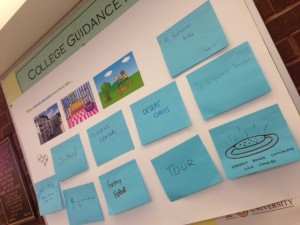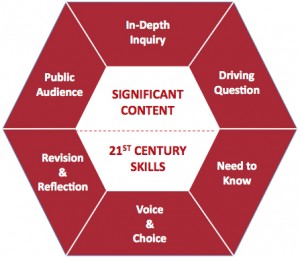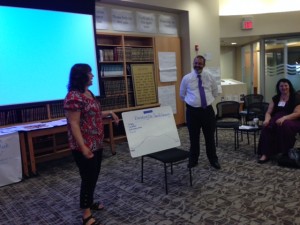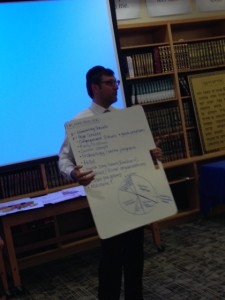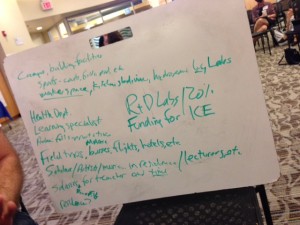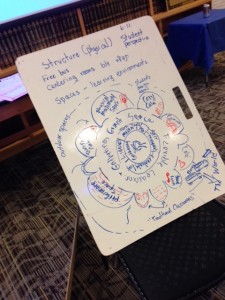I am often asked when discussing Project-Based Learning (PBL) why I would support a model of education that has no regard for the teaching or mastery of content (click here for an introduction to PBL). Why would I use a model that is solely passion and interest-based with no structure? Isn’t PBL basically what we did in kindergarten when we finger painted and built houses out of popsicle sticks? Where is the content?
These would be great questions if they were based on anything but a lack of understanding of what PBL is. To the uninitiated, PBL is often seen as a model that encourages chaos with no substance. Projects with no purpose. Learning with no….well, learning. All of these things could not be further from the truth and in PBL, content is still king. The only difference between PBL and more traditional methods is that content shares the throne with seven other kings.
Back in 2010, the Buck Institute for Education (BIE) wrote a paper for the September issue of Educational Leadership from ASCD to help educators understand the difference between PBL and just doing projects. They broke PBL down into these eight “essential” elements:
- Significant content
- A need to know
- A driving question
- Student voice and choice
- 21st century skills
- Inquiry and innovation
- Feedback and revision
- Publicly presented content
You can read more about each element by clicking here and Tikvah Wiener and I will be exploring these elements on the I.D.E.A. Schools Network blog. However, as you can see, the first element listed is Significant Content. It is the foundation of every PBL project. It is just that where more traditional models start and end with the content, PBL is only getting started. Although, to be accurate, PBL starts with the end in mind by working backwards from driving questions that propel the learning forward. The content exists to support exploration and discovery towards answering the driving question and, in turn, solving a problem or accomplishing a goal put forth by the question. We will be discussing more about driving questions when we write about that essential element. For now, the question is how do we ensure that significant content is part of PBL?
Michael Gorman, on his award winning blog 21st Century Educational Technology and Learning, lists ten ways to answer this important question.
- The entry event should show a relationship to the Driving Question promoting a “need to know” of significant content.
- The Driving Question should allow students to uncover the curriculum in a student friendly and understandable manner.
- The PBL planning sheet for students should line up with significant content in the curricular area being studied and assessed.
- The project should be ongoing and made up of activities and lessons that facilitate the learning of significant content.
- Formative learning activities and assessments that teach and reinforce the significant cont should occur throughout the timeline of the project.
- While innovative and student centered learning is encouraged, scaffolding of the project can still include traditional lecture, tests, and textbook reading. that promote significant content. Yes… rich engaging lectures can be used!
- There should be rubrics developed that evaluate student learning outcomes and they should be aligned with significant content.
- The final project should not only emphasize the 21st century skills, but should show the learning and understanding of significant content.
- Final outcome should include more than learning of significant content, but also application and connections of content to real world.
- When planning projects teachers should consider Common Core as part of their significant content.
You can read the entire post by clicking here.
Another example of where the significant content fits in can be seen in this sample Algebra project overview from BIE (click here). This is a great template to start designing your own PBL unit, but I want to point your attention to the “Content and Skills Standards” box. In this unit it is clear that the students will learn significant content and skills in the area of Algebra II/Trigonometry. However, if you read the language carefully you will understand what make this uniquely PBL. The content and skills being taught and learned are not passively transmitted. The goal with the content is that the “student will be able to…..” utilize the content and skills to accomplish something, solve a problem and demonstrate their knowledge. The content serves a purpose and does not exist solely to be understood. It must be applied.
The usual follow up question to this explanation is that while it all sounds nice, does it work? Do the student actually learn the content? The answer is simply, yes. PBL students not only learn content knowledge as well as traditional students, they appear to learn it better (Boaler, 1997; Penuel & Means, 2000; Stepien, et al., 1993). More importantly, they not only demonstrate this knowledge for assessments, but show longer retention and a deeper understanding of the content (Penuel & Means, 2000; Stepien, Gallagher & Workman, 1993). The research also points to that fact that the effectiveness of PBL is not limited to peripheral courses such as electives, but impacts teaching and learning across the curriculum (Beckett & Miller, 2006; Boaler, 2002; Finkelstein et al., 2010; Greier et al., 2008; Mergendoller, Maxwell, & Bellisimo, 2006).
Content is still king in PBL despite it sharing the title with seven other essential elements. In fact, in regard to the understanding and acquisition of the content, it may have dethroned more traditional models of teaching and learning content.
References:
Beckett, G. H., & Chamness Miller, P. (2006). Project-based second language and foreign language education: Past, present, future. Greenwich, Connecticut: Information Age Publishing.
Boaler, J. (1997). Experiencing school mathematics: Teaching styles, sex, and settings. Buckingham, UK: Open University Press.
Finkelstein, N., Hanson, T., Huang, C., Hirschman, B., and Huang, M. (2010). Effects of problem based economics on high school economics instruction. (NCEE 2010-4002). Washington, DC: National Center for Education Evaluation and Regional Assistance, Institute of Education Sciences, U.S. Department of Education.
Geier, R., Blumenfeld, P. C., Marx, R. W., Krajcik, J. S., Fishman, B., Soloway, E., & Clay-Chambers, J. (2008). Standardized test outcomes for students engaged in inquiry-based science curricula in the context of urban reform. Journal of Research in Science Teaching, 45(8), 922-939.
Mergendoller, J., Maxwell, N., & Bellisimo, Y. (2006). The effectiveness of problem-based instruction: A comparative study of instructional methods and student characteristics. Interdisciplinary Journal of Problem-based Learning, 1(2), 49-69.
Penuel, W. R., & Means, B. (2000). Designing a performance assessment to measure students’ communication skills in multi-media-supported, project-based learning. Paper presented at the Annual Meeting of the American Educational Research Association, New Orleans.










